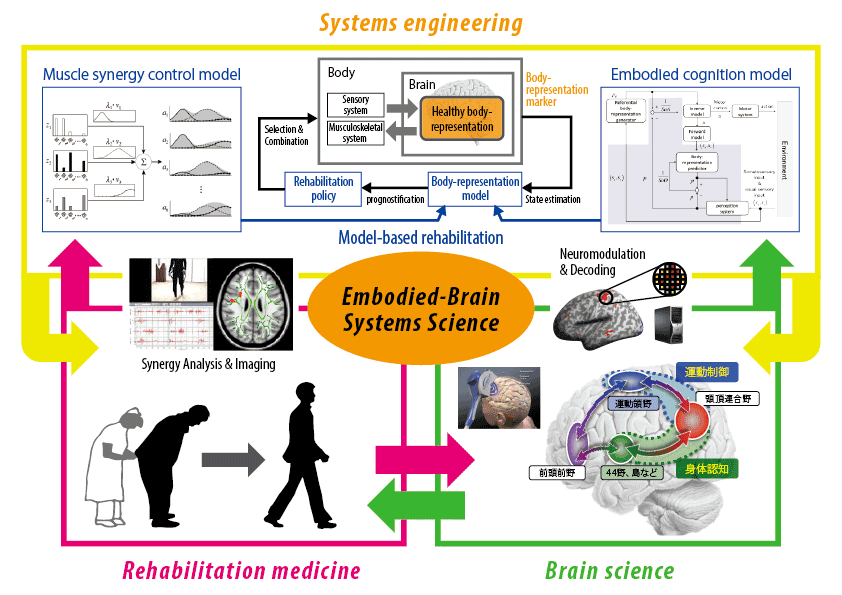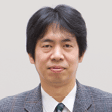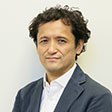 Lang: [JP][EN]
Lang: [JP][EN] As the Japanese society ages rapidly, we are experiencing a sharp increase in the number of patients of motor paralysis and other dysfunctions resulting from motor dysfunction, stroke, and neurodegenerative diseases. Thus, establishing effective rehabilitation techniques to overcome these motor dysfunctions is of paramount importance. The key to achieving this is to elucidate the mechanisms by which the brain adapts to changes in body functions. However, abnormalities in somatognosia can occur even in diseases that do not cause motor dysfunction. This indicates that we create and maintain a model of the body in the brain (body representation in the brain).
The purpose of this program is to elucidate the neural mechanisms of the body representation in the brain and the mechanism of the long-term changes in this representation and to apply these findings to rehabilitation interventions. In order to do this, we will attempt to combine brain science and rehabilitation medicine by using systems engineering (Fig. 1). We thereby intend to gain an integrated understanding of motor control and somatognosia in order to create a new academic discipline that is known as embodied-brain systems science.
As the Japanese society ages rapidly, we are experiencing a sharp increase in the number of patients of motor paralysis and other dysfunctions resulting from motor dysfunction, stroke, and neurodegenerative diseases. Thus, establishing effective rehabilitation techniques to overcome these motor dysfunctions is of paramount importance. The key to achieving this is to elucidate the mechanisms by which the brain adapts to changes in body functions. However, abnormalities in somatognosia can occur even in diseases that do not cause motor dysfunction. This indicates that we create and maintain a model of the body in the brain (body representation in the brain).
The purpose of this program is to elucidate the neural mechanisms of the body representation in the brain and the mechanism of the long-term changes in this representation and to apply these findings to rehabilitation interventions. In order to do this, we will attempt to combine brain science and rehabilitation medicine by using systems engineering (Fig. 1). We thereby intend to gain an integrated understanding of motor control and somatognosia in order to create a new academic discipline that is known as embodied-brain systems science.
Comprehensive research Management for understanding the plasticity mechanism of body representations in brain
The management group aims to lead the research program by planning research policy, managing research projects, and working on assessment and publicity of the outcome. This group regularly holds steering committee meetings to determine research policy. At the end of each fiscal year, this group plans to have annual meetings to evaluate the progress of all research projects and enhance mutual collaboration among the researchers. To promote internationalization of the program, the group holds international workshops/symposia occasionally. With regard to outreach activities, the group organizes public symposia, issues newsletters, and updates the website.
Principal Investigator Jun Ota (Professor, The University of Tokyo)
 Co-Investigator* Eiichi Naito (Research Manager, NICT CiNet)
Co-Investigator* Eiichi Naito (Research Manager, NICT CiNet)
Co-Investigator* Shin-ichi Izumi (Professor, Tohoku University)
Co-Investigator* Toshiyuki Kondo (Professor, Tokyo University of Agriculture and Technology)
Co-Investigator Hiroshi Imamizu (Professor, The University of Tokyo)
Co-Investigator Kazuhiko Seki (Director,National Center of Neurology and Psychiatry)
Co-Investigator Kaoru Takakusaki (Professor, Asahikawa Medical University)
Co-Investigator Hajime Asama (Professor, The University of Tokyo)
Co-Investigator Nobuhiko Haga (Professor, The University of Tokyo)
Co-Investigator Akira Murata (Associate Professor, Kinki University)
Co-Investigator Tetsunari Inamura (Associate Professor, National Institute of Informatics)
Co-Investigator Takashi Hanakawa (Director,National Center of Neurology and Psychiatry)
Co-Investigator Atsushi Yamashita (Associate Professor, The University of Tokyo)
Research Collaborator Yoshiaki Iwamura (Part-time Professor, Ueno Gakuen University / Emeritus Professor, Toho University)
A01-1 Neural mechanisms inducing plasticity on body representations
Our research project aims to find neural correlates of bodily self-consciousness, and neural mechanisms in which changes in bodily self-consciousness lead to changes in body representations in the brain. Based on these results, we will develop a method for intervention and manipulation of the bodily self-consciousness. In this fiscal year, we made significant advances in investigation of fast and slow dynamics in body representations, decoding bodily self-consciousness, and finding a cause of abnormality in bodily self-consciousness in schizophrenia. We also developed a new experimental paradigm for online electroencephalogram (EEG) measurement of bodily self-consciousness and for electroneurophysiological study on corollary discharge.
Principal Investigator Hiroshi Imamizu (Professor, The University of Tokyo)
 Co-Investigator* Akira Murata (Associate Professor, Kinki University)
Co-Investigator* Akira Murata (Associate Professor, Kinki University)
Co-Investigator* Yukari Ohki (Professor, Kyorin University)
Co-Investigator* Takaki Maeda (Assistant Professor, Keio University)
Co-Investigator Satoshi Shibuya (Assistant Professor, Kyorin University)
Co-Investigator Kenji Ogawa (Associate Professor, Hokkaido University)
Co-Investigator Tomohisa Asai (Researcher, NTT Communication Science Laboratories)
Co-Investigator Tsukasa Okimura (Assistant Professor, Keio University)
Co-Investigator Yuichi Yamashita (Section Chief, NCNP)
Co-Investigator Hiroaki Shigemasu (Associate Professor, Kochi University of Technology)
Co-Investigator Hiroshi Kadota (Associate Professor, Kochi University of Technology)
Co-Investigator Masahiro Yamashita (Researcher, ATR)
Co-Investigator Chang Cai (Researcher, ATR)
Co-Investigator Ryu Ohata (JSPS Research Fellow, The University of Tokyo)
Co-Investigator Kei Mochizuki (Assistant Professor, Kinki University)
Co-Investigator Masatoshi Yoshida (Assistant Professor, National Institute for Physiological Sciences)
A02-1 Neural adaptative mechanism for physical changes
Our research group is based on three major Neuroscience hub in japan (NCNP, NICT, TMIMS) and include 18 scientists. Through frequent collaboration and discussion, we would like to find how the embodied brain control our body. Aim of our collaborative study is to know the neural organization of muscle synergy generator and controller using electrophysiology and functional Brain imaging and propose the biomarker of brain plasticity on body representation. In the FY2015, we established 1) Stroke model using common marmoset, 2) understanding the fast and slow dynamics in human body cognition and motor control, and development of new fMRI decoding method, and 3) understanding on the mechanisms used by Purkinje cells to influence limb motor control and on the plastic changes that underlie motor learning in the cerebrocerebellum.
Principal Investigator Kazuhiko Seki (Director, NCNP)
 Co-Investigator* Eiichi Naito (Research Manager, CiNet)
Co-Investigator* Eiichi Naito (Research Manager, CiNet)
Co-Investigator* Shinji Kakei (Project Leader, Tokyo Metropolitan Institute of Medical Science)
Co-Investigator Kenichi Inoue (Assistant Professor, Kyoto University)
Co-Investigator Naomichi Ogihara (Associate Professor, Keio University)
Co-Investigator Tatsuya Umeda (Section Chief, NCNP)
Co-Investigator Tomomichi Oya (Section Chief, NCNP)
Co-Investigator Masaya Hirashima (Senior Researcher, CiNet)
Co-Investigator Tsuyoshi Ikegami (Researcher, CiNet)
Co-Investigator Satoshi Hirose (Researcher, CiNet)
Co-Investigator Shintaro Uehara (Assistant Researcher, CiNet)
Co-Investigator Ganesh Gowrishanker (Researcher, CNRS)
Co-Investigator Min Kyonbo (Senior Researcher, Tokyo Metropolitan Institute of Medical Science)
Co-Investigator Lee Zonho (Senior Researcher, Tokyo Metropolitan Institute of Medical Science)
Co-Investigator Takahiro Ishikawa (Researcher, Tokyo Metropolitan Institute of Medical Science)
Co-Investigator Takeru Honda (Researcher, Tokyo Metropolitan Institute of Medical Science)
Co-Investigator Kaoru Amemiya (Researcher, CiNet)
Co-Investigator Hiroshi Mitoma (Professor, Department of Medical Education, Tokyo Medical University)
A02-2 Adaptive embodied-brain function due to alteration of the postural-locomotor synergies
The present project is designed to examine cortical and subcortical mechanisms involved in the sensorimotor integration underlying anticipatory postural adjustments (APA) that precede the initiation and execution of voluntary movements. In the 2nd year of this project, experimentation in human beings and animals (monkeys and cats) have been performed. Following findings were obtained. First, APA was a feed-forward control process of controlling posture that requires motor programs and bodily information generated by fronto-parietal cortical network. Second, both the firing rate of the supplementary motor area (SMA) neurons and the contraction of paravertebral and leg muscles were higher during locomotion by biped than quadruped in the monkey. Third, reticulospinal neurons (RSNs) located in the ventral part of the pontomedullary reticular formation (PMRF), where cortico-reticular neurons abundantly projected from the motor cortical area that was relevant to the SMA in primates, were involved in the increase in the contraction of antigravity muscles of the cat. These results support our hypothesis that cortico-reticulospinal projections, arising from the SMA-ventral PMRF to the spinal cord, may have capability of the execution of APA.
Principal Investigator Kaoru Takakusaki (Professor, Asahikawa Medical University)
 Co-Investigator* Katsumi Nakajima (Professor, Iwate Medical University)
Co-Investigator* Katsumi Nakajima (Professor, Iwate Medical University)
Co-Investigator Hiroshi Funakoshi (Professor, Asahikawa Medical University)
Co-Investigator Yuriko Sugiuchi (Associate Professor, Tokyo Medical and Dental University)
Co-Investigator Yasuo Higurashi (Researcher, Kinki University)
Co-Investigator Tetsuo Ota (Professor, Asahikawa Medical University)
Co-Investigator Kazuhiro Obara (Assistant Professor, Asahikawa Medical University)
Co-Investigator Mirai Takahashi (Assistant Professor, Asahikawa Medical University)
Co-Investigator Seiji Matsumoto (Lecturer, Asahikawa Medical University)
B01-1 Modeling of slow dynamics on body representations in brain
Body consciousness such as sense of agency and sense of ownership is generated in real-time based on the body representation in brain. This process can be called “fast dynamics.” On the other hand, the body representation is created, updated and transformed through perceptional and motion experience, which can be called “slow dynamics.” In this group, these dynamics on the process creating and updating body representation in brain related to body consciousness are investigated and modeled mathematically. The concrete objectives of B01 research group are mathematical modeling of creation of body consciousness and transformation of body representation of brain, verification of cognition-body mapping model, and examination of its application to model-based rehabilitation.
Principal Investigator Hajime Asama (Professor, The University of Tokyo)
 Co-Investigator* Toshiyuki Kondo (Professor, Tokyo University of Agriculture and Technology)
Co-Investigator* Toshiyuki Kondo (Professor, Tokyo University of Agriculture and Technology)
Co-Investigator* Hirokazu Tanaka (Associate Professor, Japan Advanced Institute of Science and Technology)
Co-Investigator* Shiro Yano (Assistant Professor, Tokyo University of Agriculture and Technology)
Co-Investigator* Jun Izawa (Associate Professor, University of Tsukuba)
Co-Investigator Atsushi Yamashita (Associate Professor, The University of Tokyo)
Co-Investigator Masafumi Yano (Emeritus Professor, Tohoku University)
Co-Investigator Qi An (Research Assistant Professor, The University of Tokyo)
Co-Investigator Wen Wen (Researcher, The University of Tokyo)
B02-1 Modeling of motor control that alters body representations in brain
Body representation in brain plays an important role for the generation of adaptive motor functions (fast dynamics), while it gradually alters to adapt to the changes of several conditions by brain plasticity (slow dynamics). Meanwhile, muscle activities are represented by low dimensional structure composed of characteristic spatiotemporal patterns depending on tasks. This structure is well-known as muscle synergy and viewed as a neural strategy for simplifying the control of multiple degrees of freedom in biological systems. In this project, to elucidate mechanisms of the body representation in brain for adaptive motor control, we aim to construct fast and slow dynamics models by focusing on muscle synergy. We assume that the alteration of muscle synergy structure reflects the alteration of the body representation in brain, and we clarify the contribution of the body representation in brain through modeling the fast and slow dynamics of the synergy structure.
Principal Investigator Jun Ota (Professor, The University of Tokyo)
 Co-Investigator* Shinya Aoi (Lecturer, Kyoto University)
Co-Investigator* Shinya Aoi (Lecturer, Kyoto University)
Co-Investigator* Ryosuke Chiba (Associate Professor, Asahikawa Medical University)
Co-Investigator Taiki Ogata (Assistant Professor, The University of Tokyo)
Co-Investigator Dai Yanagihara (Associate Professor, The University of Tokyo)
Co-Investigator Kazuo Tsuchiya (Emeritus Professor, Kyoto University)
Co-Investigator Toshio Aoyagi (Professor, Kyoto University)
Co-Investigator Soichiro Fujiki (Assistant Professor, The University of Tokyo)
Co-Investigator Shohei Shirafuji (Researcher, The University of Tokyo)
Co-Investigator Yu Yong (Professor, Kagoshima University)
C01-1 Neurorehabilitation based upon brain plasticity on body representations
The number of those who have disorder in brain function, motor and sensory functions after stroke, has been rising because the number of stroke survivors is increased owing to the advance of clinical medicine. This situation creates a great need for effective rehabilitation for motor impairment and many types of rehabilitative approaches have been produced. Although some techniques improve temporally motor impairment immediately after intervention, the patients with hemiparesis tend not to use a paretic limb gradually in everyday life, because they cannot control their paretic limb as they intend. This is because the current rehabilitation approaches are not enough for a paretic limb to be a functional limb, which is a limb the patients want to use for some purpose in daily living. To make a paretic limb functional one is not only that the paretic limb is improved in function but also that brain can recognize a paretic limb as an own body part and send an appropriate motor command to the paretic limb. For this purpose, we hypothesized that there would be the cognitive mapper of body, which is a neural mechanism for estimating the body state and the environment neighboring to body utilizing the information from sensory and motor information. The states in body parts including paretic limb of the patients with hemiparesis would be coded in this mapper in the brain and this mapper could bring the body consciousness, such as body ownership and self-agency, to us when we move a body part. According to previous studies, because this mapper seems to be very flexible to the change in the body and environments, the body consciousness generated by the mapper also change when this mapper change. Thus, although it is natural that we could access the cognitive mapper of body in the brain through the body consciousness, we have no way to know and measure the change of the mapper by an intervention to body consciousness. Firstly, in our group we focus on the two unique phenomena; the abnormality in perception of gravity in body after brain damage and abnormal sensation of amputated limb. For a new approach in neurorehabilitation, we try to measure and visualize this mapper in the patients with abnormal body representation by psychophysical method and to correct the mapper.
Principal Investigator Shin-ichi Izumi (Professor, Tohoku University)
 Co-Investigator* Tetsunari Inamura (Associate Professor, National Institute of Informatics)
Co-Investigator* Tetsunari Inamura (Associate Professor, National Institute of Informatics)
Co-Investigator Naofumi Tanaka (Professor,Teikyo University)
Co-Investigator Yutaka Oouchida (Associate Professor, Osaka Kyoiku University)
Co-Investigator Kazumichi Matsumiya (Professor, Tohoku University)
Co-Investigator Hiroaki Abe (Lecturer, Kohnan Hospital)
Co-Investigator Yusuke Sekiguchi (Lecturer, Tohoku University)
Co-Investigator Masahiko Ayaki (Associate Professor, Keio University)
Co-Investigator Mitsuhiro Hayashibe (Professor, Tohoku University)
C02-1 Rehabilitation for postural/movement impairments using sensory intervention
To perform motion properly, various types of sensory input must be reflected in posture/motor control prior to or concomitantly with the motion. Thus, the motor impairment is not just a musculoskeletal problem and related to sensory problems. Therefore, motor impairment can be improved through sensory intervention. In posture/movement impairments, the temporal and spatial activity patterns of systemic muscles are impaired, and muscle synergy control may have abnormalities. It is not fully understood how muscle synergy control is altered in motor disorders. Moreover, while daily rehabilitation is an intervention for fast dynamics (FD), it remains to be elucidated what interventions provoke slow dynamics (SD) efficiently. This project aims to elucidate abnormal muscle synergy control in motor impairment and to propose new theories for rehabilitation.
Principal Investigator Nobuhiko Haga (Professor, The University of Tokyo)
 Co-Investigator* Takashi Hanakawa (Director, NCNP)
Co-Investigator* Takashi Hanakawa (Director, NCNP)
Co-Investigator* Hiroshi Yokoi (Professor, The University of Electro-Communications)
Co-Investigator* Dai Owaki (Assistant Professor, Tohoku University)
Co-Investigator Akio Ishiguro (Professor, Tohoku University)
Co-Investigator Arito Yozu (Assistant Professor, The University of Tokyo)
Co-Investigator Masao Sugi (Associate Professor, The University of Electro-Communications)
Co-Investigator Kahori Kita (Assistant Professor, Chiba University)
Co-Investigator Shin-ichi Furuya (Associate Professor, Sophia University)
Co-Investigator Kazumasa Uehara (JSPS PD, NCNP)
A03-1 Visualization of Brain Functional Dynamism by hybrid functional analysis with real-time feedback
The purpose of this project is to create functional templates of different tasks with multi-modality technique to visualize functional dynamism and improve decoding accuracy. We investigate patients with acute and chronic stroke and epilepsy, who frequently have functional modulation and pathological representations. Our system consists of functional decoding and sensory, visual and language feedback to the patients. Long-lasting training with functional feedback would visualize functional dynamism over time.
Principal Investigator Kyousuke Kamada (Department Head/Professor, Asahikawa Medical University)
Co-Investigator Fumiya Takeuchi (Associate Professor, Asahikawa Medical University)
Co-Investigator Shusei Fukuyama (Assistant Researcher, Asahikawa Medical University)
A03-2 Neural Basis for the Reference Frame and the Functional Synergies in Controlling Eye-head Coordination
In this research area “Embodied-Brain Systems Science”, a new method called NMF (non-negative matrix factorization), has been introduced and seems to have effectively determined muscle synergies in locomotion, posture and arm movements. However, neural substrates for those muscle synergies are mostly yet to be identified. In the vestibulomotor system, activation of each semicircular canal evokes canal-specific eye and head movements. This study is aimed at identifying functional muscle synergies in canal-specific head movements and revealing how they are implemented in neural structures using electrophysiological and anatomical methods.
Principal Investigator Yuriko Sugiuchi (Associate Professor, Tokyo Medical and Dental University)
Co-Investigator Shinji Kakei (Project Leader, Tokyo Metropolitan Institute of Medical Science)
A03-3 Development of assistive technologies for rehabilitation by visualizing neural representation of muscle synergies using electroencephalography
This research project aims to visualize neural signaling and representation of muscle synergies during voluntary movements using non-invasive brain activity signal recording methods. We expect the visualizing technique could reveal transformation of neural signaling and muscle synergy organization by short and long-term motor learning.
Principal Investigator Natsue Yoshimura (Associate Professor, Tokyo Institute of Technology)
Co-Investigator Hiroyuki Kambara (Assistant Professor, Tokyo Institute of Technology)
Co-Investigator Yosuke Ogata (Assistant Professor, Tokyo Institute of Technology)
Co-Investigator Okito Yamashita (Department Head, Neural Information Analysis Laboratories, ATR)
A03-4 Human Fronto-Parietal Network for Embodied-Brain System: A Combined Electrocorticographic Decoding, Stimulation and Lesion Study
We further develop the inter-group collaboration to establish a comprehensive approach (combining our invasive neurophysiology techniques with decoding, psychology, quantitative behavioral analysis, and functional neuroimaging) for elucidation of the left and right SLFIII network. We, in particular, focus on delineating the fast dynamic alternation (functional impairment) and its transition into slow dynamics alternation (plastic change, reorganization), so that these valuable findings can be translated into clinical neuroscience and finally into patient care. We believe our clinical system neuroscience findings contribute to the Embodied-Brain System Science as important clinical reference data for the construction and verification of engineering models, and the elucidation of the long-term compensatory mechanism by rehabilitation.
Principal Investigator Riki Matsumoto (Professor, Kobe University)
Co-Investigator Akio Ikeda (Professor, Kyoto University)
Co-Investigator Takeharu Kunieda (Professor, Ehime University)
Co-Investigator Kazumichi Yoshida (Senior Lecturer, Kyoto University)
Co-Investigator Masao Matsuhashi (Associate Professor, Kyoto University)
Co-Investigator Akihiro Shimotake (Assistant Professor, Kyoto University)
A03-5 Understanding the interaction between tactile and nociceptive information in the somatosensory cortex and controlling of nociception
It remains unclear that the representation of somatotopic map of nociception. We will explore the map in the somatosensory cortex by using in vivo imaging and a newly developed noxious stimulation device. To control the activity of the nociceptive and tactile pathways, we will stimulate these pathways selectively by using optogenetics. Then, we try to understand the interaction between tactile and nociceptive information in the somatosensory cortex and uncover its neural network.
Principal Investigator Hironobu Osaki (Assistant Professor, Tokyo Women’s Medical University)
Co-Investigator Mariko Miyata (Professor, Tokyo Women’s Medical University)
Co-Investigator Yoshifumi Ueta (Assistant Professor, Tokyo Women’s Medical University)
Co-Investigator Goichi Miyoshi (Assistant Professor, Tokyo Women’s Medical University)
A03-6 Body representation changes underlying motor recovery after internal capsular stroke in macaques
This research project aims to investigate changes in neural networks , which are involved in functional compensation during the recovery of dexterous hand movements, using a macaque model of internal capsular stroke. This project also aims to develop a novel technology to monitor changes in activities and networks in motor-related cortical areas during functional recovery after brain damage and to evaluate the possibility for the clinical application in the monitoring of patients.
Principal Investigator Noriyuki Higo (Senior Researcher, AIST)
Co-Investigator Yumi Murata (Senior Researcher, AIST)
Co-Investigator Toru Yamada (Senior Researcher, AIST)
Co-Investigator Jun Izawa (Associate Professor, University of Tsukuba)
B03-1 Elucidation of the synergy reformation mechanism for neural function recovery
Coordination of motor systems: synergy reflects the change in the neural system due to certain movement dysfunction and its recovery. Muscle synergy of congenital insensitivity to pain (CIPA) patients for walking shows the enlargement of activity duration, and that of stroke patients shows different coordination structure from healthy people. This research tackles the mechanism of such a synergy reformation owing to the neural ataxia through the motion and dynamical analysis of patients and animal models, and constructs an assistant method for motor recovery based on the characteristic of synergy.
Principal Investigator Tetsuro Funato (Associate Professor, The University of Electro-Communications)
B03-2 Transformation of body representations in embodiment process of active artificial limb
The purpose of this project is to develop technologies to change an original body-representation or to obtain a new body-representation of an active robotic limb through manipulation tasks. The technologies could contribute to development of a better user-interface for robot control and usability, and improvement of a rehabilitation process. We investigate embodiment process in two approaches. 1) The robotic limb is mounted on the user’s body. 2) The robotic limb is apart from a user’s body and sensory and visual feedbacks are employed.
Principal Investigator Yasuhisa Hasegawa (Professor, Nagoya University)
B03-3 Emergence of Fast/Slow Dynamics of Body Image in Muscular Skeletal Humanoid Robot
There are two ways to acquire body image from the viewpoint of the system engineering. One is to utilize the consistency of the body and the other is to utilize the maneuverability. The latter way is to find out invariance in the maneuverability through variety of tasks, which is not discussed in the viewpoint of engineering. This research project will study on emergence of the body image based on the invariance in the maneuverability by constructing human-like muscular skeletal humanoid robots. The robot is implemented to achieve reaching, object manipulation, door-opening, and gesture displaying, and through these tasks (fast dynamics), it will find invariance in its dynamics (slow dynamics). The result will be compared with that of a human, and we generate hypothesis on humans’ cognitive system.
Principal Investigator Koh Hosoda (Professor, Osaka University)
Co-Investigator Ichiro Tsuda (Professor, Hokkaido University)
Co-Investigator Hideo Kubo (Professor, Hokkaido University)
Co-Investigator Shuhei Ikemoto (Assistant Professor, Osaka University)
B03-4 Investigation of adaptation process of the upper limb by artificially-disabled healthy participants
For effective rehabilitation of the upper extremity with functional limitation, we need to set an appropriate rehabilitation goal based on an understanding of current degree of limitation and an expected recovery status some short while later. It is, however, difficult to collect such data for recovery estimation by observing actual patients. We concentrate on human hand grasps and aim to find out adaptation in grasp strategy according to various range of motion by observing artificially-disabled healthy volunteers. We will also try to estimate recovery status in the near future by developing grasp simulator for the hand with arbitrary range of motion by incorporating adaptation model in grasp strategy.
Principal Investigator Natsuki Miyata (Senior Researcher, AIST)
Co-Investigator Koji Fujita (Assistant Professor, Tokyo Medical and Dental University)
Co-Investigator Yusuke Maeda (Associate Professor, Yokohama National University)
C03-1 The relationship between body consciousness and motor control aspects of body representation in the brain
In this study, we aim to determine the relationship between the two aspects of body representation in the brain: somatognosia and motor control. We study patients to identify the recovery courses of somatognosia and motor control during rehabilitation, and explore the underlying neural mechanisms.
Principal Investigator Arito Yozu (Associate Professor, Ibaraki Prefectural University of Health Sciences)
Co-Investigator Masashi Hamada (Assistant Professor, The University of Tokyo)
Co-Investigator Michihiro kawano (Associate Professor, Ibaraki Prefectural University of Health Sciences)
C03-2 Motor Skill Training/Analysis of brain plasticity Through Muscle Contraction Pattern-Based Direct Rehabilitation
Extensive and focused physiotherapy is needed to help individuals with disabilities, such as hemiplegics, achieve natural physical movement involving the simultaneous use of various muscles. This project aims to develop a new method for bilateral communication of joint motions, muscle cooperative patterns, forces, and joint impedance between the therapist and patient. We also try to understand the brain plasticity through motor skill training with our support method.
Principal Investigator Keisuke Shima (Associate Professor, Yokohama National University)
Co-Investigator Koji Shimatani (Professor, Prefectural University of Hiroshima)
Co-Investigator Hideki Nakano (Assistant Professor, Kyoto Tachibana University)
Co-Investigator Atsushi Tasaka (Associate Professor, Osaka Health Science University)
C03-3 Study on kinesthetic illusion induced by visual stimulation under the mixed reality and brain functional connectivity
We have developed a system to replace the subject’s own limb with an artificial body under the mixed reality given to the subject who is resting. The subject in a resting state can be induced kinesthetic illusion, as if the subject’s own body is moving, during the artificial body movement is shown. The aim of the present study is to clarify a change of the brain functional connectivity after repetitively the kinesthetic illusion was applied.
Principal Investigator Fuminari Kaneko (Associate Professor, Keio University)
Co-Investigator Yoshiyuki Asai (Professor, Yamaguchi University)
Co-Investigator Eriko Shibata (Researcher, Sapporo Medical University)
C03-4 Development of comprehensive measurement system of balance function to monitor the effect of rehabilitative interventions.
In this study, we aim to advance a comprehensive understanding of the body’s balance maintenance systems based on our previous work by measuring balance using the relationship between the center of gravity (COG) and center of pressure (COP) during stepping movements. We are planning to first observe the COG–COP relationship during physical activity or in response to perturbation and to then compare any observed differences to the subjects’ etiologies or brain lesion locations. Our final goal is to develop a comprehensive system for measuring balance function to monitor the effects of rehabilitative interventions and clarify the modifications to the motion control mechanisms during the reacquisition of the ability to balance.
Principal Investigator Masahiko Mukaino (Lecturer, Fujita Health University)
Co-Investigator Fumihiro Matsuda (Assistant Professor, Fujita Health University)
C03-5 Effect of “Hybrid-Neurorehabilitation to improve Sense of Agency” for patients with stroke hemiplegia
Following are the aims of the present study: (1) to quantitatively evaluate multisensory integration function and explicit and implicit sense of agency in patients with hemiplegia after stroke; (2) to investigate the relationship between sense of agency and severity and recovery from hemiplagia in a cross-sectional/longitudinal study; (3) to investigate the effect of Hybrid-Neurorehabilitation that improves adaptive motor learning and sense of agency.
Principal Investigator Shu Morioka (Professor, Kio University)
Co-Investigator Sotaro Shimada (Professor, Meiji University)
Co-Investigator Michihiro Osumi (Assistant Professor, Kio University)
Co-Investigator Satoshi Nobusako (Assistant Professor, Kio University)